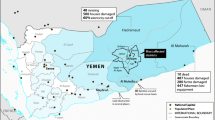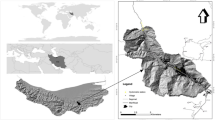Abstract
Kaynasli District in the western Black Sea region of Turkey has long been vulnerable to frequent flood damage due to the establishment of settlements within and around stream channels without regard to fluctuating peak-streamflow frequencies. The aim of this research was to determine the measures needed to protect the towns and villages from this type of damage. Daily total precipitation data for 1975–2010 were analysed, and rainfall-runoff models developed to estimate the potential yearly maximum discharge from each stream of sub-watersheds dominated by forests and/or agriculture. This was then calculated for different frequencies of the yearly maximum discharge. Flood analysis and mapping was modified via the one-dimensional Hydrologic Engineering Centers-River Analysis System software to produce potential maximum discharge and geometric data for Kaynasli Creek. As the main creek of the sub-watershed, its cross-section was shown to be insufficient and incapable of containing the maximum discharge at the 100-year frequency presumed for the watershed, and subsequently was seen as having a high level of casualty risk. It was concluded that the one dimensional model could be useful, but 2D models were more suitable for these types of watersheds.




Similar content being viewed by others
References
Abon CC, David CPC, Pellejera NEB (2011) Reconstructing the tropical storm Ketsana flood event in Marikina River, Philippines. Hydrol Earth Syst Sci 15:1283–1289
Amini JA (2010) A method for generating floodplain maps using IKONOS images and DEMs. Int J Remote Sens 31(9):2441–2456
Arora K, Singh VP (1989) A comparative evaluation of the estimators of the log Pearson type (LP) 3 distribution. J Hydrol 105:19–37
Çelik HE, Coskun G, Ciğizoğlu HK, Ağıralioğlu N, Aydın A, Esin Aİ (2012) The analysis of 2004 flood on Kozdere stream in Istanbul. Nat Hazards 63:461–477
Chatterjee C, Fröster S, Bronstert A (2008) Comparison of hydrodynamic models of different complexities to model floods with emergency storage areas. Hydrol Process 22(24):4695–4709
Chen L, Singh VP, Guo S, Hao Z, Li T (2012) Flood coincidence risk analysis using multivariate copula functions. J Hydrol Eng 17(6):742–755
Cheng Q, Ko C, Yuan Y, Ge Y, Zhang S (2006) GIS modelling for predicting river runoff volume in ungauged drainages in the Greater Toronto Area, Canada. Comput Geosci 32:1108–1119
Cook A, Merwade V (2009) Effect of topographic data, geometric configuration and modelling approach on flood inundation mapping. J Hydrol 377(1):131–142
Dawod GM, Mirza MN, Al-Ghamdi KA (2011) GIS-based spatial mapping of flash flood hazard in Makkah City, Saudi Arabia. J Geogr Inf Syst 3:225–231
Geetha K, Mishra SK, Eldho TI, Rastogi AK, Pandey RP (2008) SCS-CN-based continuous simulation model for hydrologic forecasting. Water Resour Manage 22:165–190
Griffis VW, Stedinger JR (2007a) Log-Pearson type 3 distribution and its application in flood frequency analysis. I: distribution characteristics. J Hydrol Eng 12(5):482–491
Griffis VW, Stedinger JR (2007b) Log-Pearson type 3 distribution and its application in flood frequency analysis. II: parameter estimation methods. J Hydrol Eng 12(5):492–500
Griffis VW, Stedinger JR (2009) Log-Pearson type 3 distribution and its application in flood frequency analysis. III: sample skew and weighted skew estimators. J Hydrol Eng 14(2):121–130
Haile AT, Rientjes THM (2005) Effects of LIDAR DEM resolution in flood modelling: a model sensitivity study for the city of Tegucigalpa, Honduras. In: ISPRS WG III/3, III/4, V/3 Workshop “Laser scanning 2005”. Enschede, The Netherlands, pp 168–173
Horritt MS, Bates PD (2002) Evaluation of 1D and 2D numerical models for predicting river flood inundation. J Hydrol 268:87–99
IACWD (1982) Guidelines for determining flood flow frequency: bulletin 17-B, Hydrology Subcommittee. US Department of the Interior Geological Survey, Reston, VA, pp 9–10
Jain MK, Mishra SK, Singh VP (2006) Evaluation of AMC dependent SCS-CN based models using watershed characteristics. Water Resour Manag 20(4):531–552
Khaliq MN, Ouarda TBMJ, Ondo JC, Gachon P, Bobee B (2006) Frequency analysis of a sequence of dependent and/or non-stationary hydro-meteorological observations: a review. J Hydrol 329:534–552
Kirpich ZP (1940) Time of concentration of small agricultural watershed. ASCE Civ Eng 10(6):362
Koutrouvelis IA, Canavos GC (2000) A comparison of moment-based methods of estimation for the log Pearson type 3 distribution. J Hydrol 234:71–81
Lastra J, Fernandez E, Diez-Herrero A, Marqueinez J (2008) Flood hazard delineation combining geomorphological and hydrological methods: an example in the Northern Iberian Peninsula. Nat Hazards 45:277–293
Matgen P, Schumann G, Henry JB, Hoffmann L, Pfister L (2007) Integration of SAR-derived river inundation areas, high precision topographic data and a river flow model toward near real-time flood management. Int J Appl Earth Obs Geoinf 9(3):247–263
McCuen R, Bondelid T (1983) Estimating unit hydrograph peak rate factors. J Irrig Drain Eng 109(2):238–250
Mishra SK, Singh VP (2006) A relook at NEH-4 curve number data and antecedent moisture condition criteria. Hydrol Process 20(13):2755–2768
Mishra SK, Singh VP, Sansalone JJ, Aravamuthan V (2003) A modified SCS-CN method: characterization and testing. Water Resour Manag 17(1):37–68
Mishra SK, Jain MK, Singh VP (2004) Evaluation of the SCS-CN-based model incorporating antecedent moisture. Water Resour Manag 18(6):567–589
Mishra SK, Jain MK, Bhunya PK, Singh VP (2005a) Field applicability of the SCS-CN-based Mishra-Singh general model and its variants. Water Resour Manag 19(1):37–62
Mishra SK, Jain MK, Pandey RP, Singh VP (2005b) Catchment area-based evaluation of the AMC-dependent SCS-CN inspired rainfall-runoff models. Hydrol Process 19(14):2701–2718
Mishra SK, Sahu RK, Eldho TI, Jain MK (2006) An improved Ia–S relation incorporating antecedent moisture in SCS–CN methology. Water Resour Manag 20(5):643–660
Mishra SK, Pandey RP, Jain MK, Singh VP (2008) A rain duration and modified AMC-dependent SCS-CN procedure for long duration rainfall-runoff events. Water Resour Manag 22:861–876
Naghavi B, Yu FX (1996) Selection of parameter-estimation method for LP3 distribution. J Irrig Drain Eng 122(1):24–30
NRCS (2000) National engineering handbook: Part 630 hydrology, Chapter 18: selected statistical methods. US Department of Agriculture, Natural Resources Conservation Service, Washington, DC, pp 76-91
Phine HN, Hira MA (1983) Log Pearson type 3 distribution: parameter estimation. J Hydrol 64:25–37
Ponce VM, Hawkins ERH (1996) Runoff curve number: has it reached maturity? J Hydrol Eng 1(1):11–19
Pramanik N, Panda RK, Sen D (2010) One dimensional hydrodynamic modeling of river flow using DEM extracted river cross-sections. Water Resour Manag 24:835–852
Reddy GPO, Maji AK, Gajbhiye KS (2004) Drainage morphometry and its influence on landform characteristics in a basaltic terrain, Central India—a remote sensing and GIS approach. Int J Appl Earth Observ Geoinf 6(1):1–16
Sahu RK, Mishra SK, Eldho TI, Jain MK (2007) An advanced soil moisture accounting procedure for SCS curve number method. Hydrol Process 21:2872–2881
SCS (1971) National engineering handbook, section 4: hydrology. US Department of Agriculture, Soil Conservation Service, Washington, DC, p 127
SCS (2004) National engineering handbook: part 630 hydrology, chapter 10: estimation of direct runoff from storm rainfall. US Department of Agriculture, Soil Conservation Service, Washington, DC, p 79
Soulis KX, Valiantzas JD (2012) SCS-CN parameter determination using rainfall-runoff data in heterogeneous watersheds—the two-CN system approach. Hydrol Earth Syst Sci 16(3):1001–1015
Soulis KX, Valiantzas JD, Dercas N, Londra PA (2009) Investigation of the direct runoff generation mechanism for the analysis of the SCS-CN method applicability to a partial area experimental watershed. Hydrol Earth Syst Sci 13(5):605–615
Sui J (2005) Estimation of design flood hydrograph for an ungauged watershed. Water Resour Manag 19:813–830
USACE (1993) Hydrologic frequency analysis, EM-1110-2-1415. US Army Corps of Engineers, Washington, DC, p 149
USACE (2005) HEC-GeoRAS GIS tools for support of HEC-RAS using ArcGIS. US Army Corps of Engineers, Hydrologic Engineering Center, Davis, CA, p 204
USACE (2010a) HEC-RAS River Analysis System, User’s Manual. US Army Corps of Engineers, Hydrologic Engineering Center, Davis, CA, p 790
USACE (2010b) HEC-RAS river analysis system, hydraulic reference manual. US Army Corps of Engineers, Hydrologic Engineering Center, Davis, CA, p 417
Vogel RM, Thomas WO, McMahon TA (1993) Flood-flow frequency model selection in southwestern United States. J Water Resour Plan Manag 119(3):353–366
Wicks JM, Hu C, Scott M, Chen L, Cheng X (2013) A broad scale model for flood simulation in the Taihu Basin, China. J Flood Risk Manag 6:33–41
Youssef AM, Pradhan B, Hassan AM (2011) Flash flood risk estimation along the St. Katherine road, Southern Sinai, Egypt using GIS based morphometry and satellite imagery. Environ Earth Sci 62(3):611–623
Author information
Authors and Affiliations
Corresponding author
Additional information
Project funding: None.
The online version is available at https://www.springerlink.com
Corresponding editor: Zhu Hong.
Rights and permissions
About this article
Cite this article
Karagül, R., Çitgez, T. Estimation of peak runoff and frequency in an ungauged stream of a forested watershed for flood hazard mapping. J. For. Res. 30, 555–564 (2019). https://doi.org/10.1007/s11676-018-0650-5
Received:
Accepted:
Published:
Issue Date:
DOI: https://doi.org/10.1007/s11676-018-0650-5




